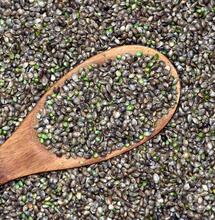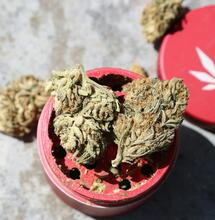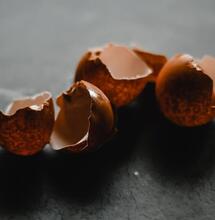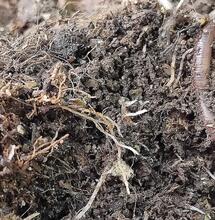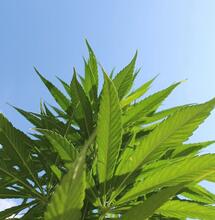Can You Build and Fill Your House with Hemp?

Hemp offers a renewable, non-toxic, breathable and durable alternative to common construction materials that can result in even stronger homes. You can basically build an entire house from hemp, including furniture, insulation, roofing, garden elements, and pretty much everything that is otherwise made of plastic, wood, concrete, etc. In this article, learn more about how hemp can be used as a sustainable, environmentally-friendly alternative to plastic and traditional building materials.
Mother Nature takes with one hand and gives with the other. While the destructive force of fires, floods, hurricanes and other devastating incidents causes billions of dollars'-worth of damage across the planet each year, a natural building material that grows in the ground could provide some respite (and no, trees are not the answer).
Hemp provides an environmentally-friendly, sustainable, renewable product that requires low energy to produce. Hemp building materials can sequester carbon and reduce CO2 emissions, while providing an air-tight, chemical-free living environment. Extremely energy-efficient, hemp construction products can effectively reduce heating and cooling bills during the entire life of the structure.
For thousands of years, hemp plants have been used to produce tens of thousands of industrial products. Whether you require traditional adobe or lime wash, I-beams or insulation, different parts of this useful plant can offer extremely versatile, energy-efficient, non-toxic, environmentally-friendly alternatives to common building materials as well as plastic. All while being grown in an ecologically-sound and sustainable manner.
Hemp building materials are fire-resistant – great for those living in areas prone to forest fires – in addition to being breathable and yet nearly impermeable to running water and the destructive, expansive force of ice formation. Structures built from hemp materials are able to expand and contract in accordance with the elements. Earthquakes, tornadoes and hurricanes will much more easily destroy personal homes constructed of regular bricks, metal or wood than those built from hemp construction products.
Environmental Benefits of Hemp Building Materials
In addition to providing a safe, healthy structure with good longevity, hemp building materials are also better for the environment than their counterparts. Hemp plants can be grown almost anywhere on the planet – save for the regions where their cultivation remains illegal – with few or no pesticides at all.
Unlike many commercial crops, growing hemp actually improves the land, rather than depleting it. It should be noted that many folks have either misinterpreted what hemp is or have simply been misinformed. Hemp plants are Cannabis plants, but their flowers cannot be smoked or otherwise consumed for recreational purposes (while hemp does offer many medicinal benefits and products, this article is not where they will be outlined – check back here for more info on hemp as medicine).
When Cannabis flowers are monitored by international authorities, any plants testing at less than 0.1 percent THC – tetrahydrocannabinol, the main psychoactive cannabinoid in recreational ‘marijuana’ plants – are considered hemp and are, therefore, legal in many countries. Technically, you can smoke hemp; however, not only will it not get you high but your lack of a high will be compounded by a nasty headache. Instead, over twenty-thousand products can be made from hemp plants, utilizing every single part of the plant, including the roots.
With regards to hemp building materials, however, the stalk is the only plant part considered useful for such purposes, while the flowers and roots are used to manufacture tinctures and other medications – hemp flowers are the most common source of the medicinal CBD oil that is currently sweeping the globe. The seeds offer a protein-rich source of all the Omega fatty acids, in the perfect ratio for absorption. Hemp seed oil, hemp milk and thousands of different food products are manufactured from hemp seeds, which are actually achenes or nuts.
Hemp plants breathe in carbon dioxide and release oxygen, scrubbing our air of toxins and pollution – four times more so than trees. Hemp also matures far faster than the twenty-some years required for trees to do so, with hemp being harvested after a mere three to four months instead. Additionally, an acre of hemp produces more cellulose fiber pulp than 4.1 acres of trees, as noted also in a 1916 Department of Agriculture bulletin (Dewey & Merrill, Bulletin #404, U.S. DoA).
Cultivation of hemp plants aids in prevention of erosion, rids the soil of harmful contaminants (e.g., hemp was planted at Chernobyl and the sites of other nuclear disasters to decontaminate the area) and prevents fallow fields via nitrogenation, thus it is perfect for crop rotation. Other crops used in the production of homes and their related goods, such as cotton or soy, strip the land of nutrients, depleting the soil, while trees require much more space and time to become fruitful.
Hemp Versus Concrete
Climate change has become a hot-button issue over the last decade, and with good reason. Eco-minded consumers are now more aware than ever of their own carbon footprint, which is compounded by the choices we make in selecting and purchasing different products throughout our lifetimes – not just what we drive or how often we fly somewhere in an airplane.
In comparative terms, concrete is more environmentally-friendly than other building materials, such as asphalt, steel, wood or aluminum, due to its insulating properties and inherent ability to lower operating costs throughout the lifetime of a structure. Although concrete does absorb carbon dioxide, it is also responsible for releasing it during its production, mostly during the burning and drying stages.
Fossil fuels are used as the energy source for burning, but the calcination (calcining) process – when calcium carbonate is heated and breaks down to release both calcium oxide and carbon dioxide – is responsible for between fifty and sixty percent of the CO2 emissions resulting from concrete manufacturing.
Cement, the powdery gray dust used in concrete production, acts as the glue or binding agent. Portland cement is the most commonly-used type that is currently available in the United States. The EPA estimates that, for every 2,205 pounds (1,000 kilos or just over a ton) of concrete produced, between 1,984 and 2,425 pounds (900 to 1,100 kilos) of CO2 are released into the atmosphere. The Portland Cement Association or PCA places this average at around 2,044 pounds of CO2 released per 2,205 pounds of manufactured concrete.
Approximately 170 to 500 pounds of CO2 per cubic yard (about 100 to 300 kilos per cubic meter) is embodied within the concrete; however, a 2007 study suggests that between thirty-three and fifty-seven percent of CO2 is reabsorbed into the product throughout its life cycle, estimated at 100 years, via a process called carbonation.
In contrast, hemp concrete is carbon-negative and there are currently around a dozen high-profile companies retailing this product around the globe. Hemp Technologies, for example, estimates that a ton of their Hempcrete will “absorb and sequester” about 550 pounds of carbon dioxide over a period of a hundred years. When mixed with a lime binder, just one fifteen-kilo bag of their hemp material will produce around five cubic feet of Hempcrete, allowing for lower construction costs than other materials.
Hemp Products for the Chemically-Sensitive or Allergy Sufferers
Those suffering from asthma, allergies or Multiple Chemical Sensitivity (also known as MCS, environmental illness, idiopathic environmental intolerance or total allergy syndrome) may be completely cured of some or all of their ailments by living in a clean-air, toxin-free home. Nearly all chemical constituents of an average house – plastics, synthetic fibers, carpeting, glue/resin, paints, petroleum products, etc. – can be replaced altogether by hemp-based products, completely eliminating common chemicals from your living space.
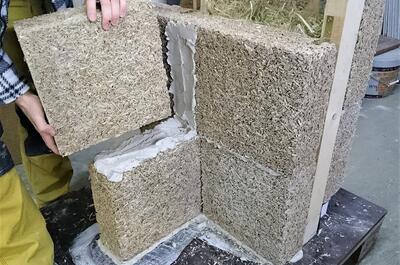
How Hemp Building Materials are Made?
Two main parts of the hemp stalk are typically used to produce paper, textiles, cordage and building materials, which is the long, outer bast fibers and woody inner core, comprised of short fibers known as the hurds or shives of the plant.
Bast fibers can be harvested at a length of between three and fifteen feet, optimal for creating large, seamless pieces of fabric – perfect for sailcloth but curtains will work, too – which may also be cut to specific lengths.
Hemp hurds are the much shorter, tougher fibers that contain between forty-four and fifty-five percent cellulose, sixteen to eighteen percent hemicellulose and four to twenty-eight percent lignin. The commercial process for isolating such fibers results in waste cellulose production, which can then be used to make various types of hemp ‘plastic’ or hemp fuel (biodiesel).
Hemp bast fibers are separated from the woody shives via a process known as decortication, which must be done with special equipment, as the fibers are so tough and difficult to work with that they tend to jam up or even break other machinery.
Common incarnations of hemp building materials include: concrete pipes, bricks, fiberboard, roofing, wallboard, cement particle board, paint plaster, flooring insulation, reinforced concrete, paneling spray-on insulation, plywood caulking, biodegradable plastic composites, insulation panels, etc.
Hemp Structure for Homes
Hemp fibers have a tensile strength that is up to ten times higher than steel at about two-thirds of the weight and are mold- and fire-resistant, in addition to presenting a natural alternative to chemical products, thereby offering a safe option for allergy sufferers and those with a sensitivity towards chemical products.
A natural thermal insulator that locks in heat during the cold winter months and keeps out the hot summer sun, hemp walls, floors and ceilings are the perfect material for constructing a sturdy home that is also relatively immune to the damaging severity that the elements can sometimes thrust upon us.
Superior strength, durability and longevity, ease-of-use and sustainability make this lightweight material a brilliant choice for houses, office buildings, music studios, hotels and more. Hemp concrete, for example, is an extremely effective insulator and rodent repellant, is insect-resistant and has the ability to withstand water and fire damage, in addition to being non-toxic and mold-resistant.
Most hemp building materials have good vapor permeability, with regards to capillary action and hygroscopicity (the ability to absorb or attract moisture from the air), preventing rooms from becoming stuffy. Hempcrete can also be used in load-bearing structures, in combination with timber, concrete or metal (e.g., aluminum or steel) frameworks.
More benefits of hemp concrete include the fact that it is easy to use, provides racking strength and allows for increased spacing members in frame construction. Timber frames can be stiffened by and supported with hempcrete, as well as being protected from premature deterioration, due to its fungus- and water-resistant properties. The product can be mixed on-site, reducing transport and manufacturing costs.
Raw hemp material is usually mixed with hydraulic lime to create hemp concrete. Combining hemp concrete with lime, cement, plaster, sand and a bit of water to dampen the mix results in a material that is perfect for laying either a horizontal foundation or foundation walls directly into the soil.
Unlike pretty much all other building materials, hemp structures actually harden and strengthen with age, effectively fossilizing and eventually turning into stone. According to sources, hemp foundation walls are seven times stronger than concrete foundations, half as light and three times as elastic, which means that these building will bend, but not break. Because of their singular strength and flexibility, hemp foundations are resistant to stress-induced cracking and breaking. Even earthquakes and other natural disasters cannot break or crack these structures.

Hemp Boards
Hemp can be used as a thermally-sound replacement for wood in the production of low-maintenance planks, particle board or MDF. These hemp boards are often custom-made, but since hemp’s popularity as environmentally-friendly material is growing, more and more building and construction companies have started to offer a standard, pre-cut bulk options for purchasing.
Exterior hemp boards may be laminated or varnished with a variety of finishes, although hemp-based products would be optimal. Which is the perfect opportunity to combine hemp with more hemp, thereby increasing the longevity of the product while reducing the negative environmental impact. Eco-acrylic or phenolic resin may be applied in order to seal the product, although an even more natural alternative is available in the form of additional lignin, a plant polymer.
Insulating hemp boards are a popular application of the plant’s properties on the exterior of a structure. Particle boards may be fused with melamine-fortified UF resin (in keeping with strict regulatory standards). This results in little to no off-gassing of formaldehyde, typically a primary concern when dealing with such materials.
Hemp boards can be employed both indoors and on the exterior of the home or structure. For example, exterior applications might include roofing shingles or siding, while interior use includes any replacement of sheet rock/drywall or wooden products, meaning that they are the perfect construction component.
When seeking hemp boards for purchase, be sure to ascertain the product’s ranking within the parameters of the American Natural Standard's Institute (ANSI) with regards to performance and internal bond strength.
Interior Hemp Home Components
Since hemp building materials along the lines of boards, bricks and concrete are relatively non-combustible and mold- and water-resistant, it makes sense that interior applications are also possible.
For those with severe allergies, asthma or simply a concern about carbon footprints and consumption of chemical-based or otherwise synthetic products, a natural, chemical-free alternative is readily available. In fact, people have been making homes, fabric, cordage, paper, lamp oil, paints and varnishes from hemp for thousands of years.
Hemp boards can be raw (unfinished), sanded, highly polished or laminated to produce the desired finish. Inside the house, hemp boards are used in the construction of walls, window frames, floors and under-floors, cabinetry, both the exterior and inner core of doors, counter-tops, furniture, shelving, construction of media/entertainment centers and television stands and even acoustic ceiling tiles.
Dispersal of sound, temperature, moisture, wind/air and light can all be controlled via hemp construction components. Bespoke stucco or adobe molded features, such as lighting sconces, telephone nooks, storage recesses, art displays, book shelves and more can all be built-in, blending seamlessly and naturally with the inner home structure. Such features are easy to incorporate and also help to strengthen the interior structure of your home.
Hempcrete, bricks, I-beams, particle board, carpeting, insulation (hemp 'wool'), prefabricated panels, ceiling tiles and more can be incorporated into your home. In the tragic event of a house fire, such materials not only catch fire much more slowly than their synthetic counterparts, but they also release far fewer life-threatening chemicals when eventually combusted, allowing for a greater chance of success in safely escaping such an event. Even fire fighters may be safer when battling such a fire, as they will be exposed to far fewer dangerous elements – it is known that most victims of house fires succumb to toxic fumes before the fire itself can harm them.
Decorating with Hemp
While the exterior structure of your home can certainly be strengthened by hemp building materials, the interior may also be fitted with hemp textiles and other products, besides furniture.
Hemp textiles produce strong, flexible, durable and comfortable upholstery, pillow stuffing, drapes/curtains, carpeting, hammocks and webbing, which presents a natural alternative to polyester or nylon.
Hemp twine can be used for making jewelry or art pieces, used as cordage for binding packages (wrapped in hemp paper, of course), clotheslines, netting for shopping bags or sporting nets, such as a basketball hoop or hockey goal, crafts or pet-related merchandise.
Hemp stalks can be incorporated into artwork or used to create easels for showcasing such art pieces.
Hemp Furniture
The benefits of hemp furniture include durability, a lightweight quality, flexibility, longevity and comfort – in addition to being non-toxic and hypoallergenic.
Several major companies have been producing hemp furniture for years. There are examples of companies that make beautiful hemp couches and sofa beds, combining traditional sturdy Amish craftmanship and attention to detail with the eco-friendly and hypo-allergenic hemp fabric. The result is durable furniture that is less toxic than similar items on the commercial market. Such products can easily be sourced on the Internet. If a simpler approach is preferred, dried hemp stalks can even be used to create a base for stools or chairs, or perhaps small end tables.
The same technique utilized in the production of composite panels in the automobile industry may also be employed in crafting unique, made-to-order interior components, such as furniture, benches or other seating, room partitions or a even a wet or dry bar.
Injection-molded composite pieces made from hemp hurds and shives are quite popular; the same manufacturer also produces musical instruments. Typically, injection-molded panels made from a combination of hemp, flax, kenaf and fiberglass that are normally used in the production of cars can substitute plastic, resin, metal or wooden structures or pieces of furniture. Even paints and varnishes are, and have been for generations, manufactured with hemp as a primary ingredient, increasing the overall percentage of natural, non-chemical products within the home.

Hemp in the Yard and Garden Components
Few more smart utilizations of hemp around the house? Let’s take a look at how hemp can brighten up your outdoors.
Hemp Animal Bedding
After disposal, hemp animal bedding biodegrades two times faster than wood chips or straw. Available in different grades, hemp bedding is suitable for smaller pets, such as hamsters, gerbils, chinchillas, rabbits and currently trendy chickens to large animals, such as horses. Since hemp plants can be grown with little to no pesticides, as usually is the case, there is far less occurrence of chemical residues being transferred to the animals.
Completely non-toxic and boasting a relatively minimal dust content and low palatability, hemp animal bedding is perfect for pet owners concerned about their animals’ respiratory health and other medical issues. This bedding is the most absorbent product available commercially, as it is capable of absorbing four times its own weight, meaning that it will also stay dry for a longer period of time than straw or wood shavings.
Around thirty pounds of hemp bedding will cover a chicken coop that is about twenty-five square feet at a depth of about two inches and last months longer than most commercial products, saving you costs in terms of dollars, time and labor. When it has become soiled and is discarded of, it can be added to the compost pile to create a valuable, nutrient-rich additive for fruit trees, berry shrubs and flower- or vegetable gardens, saving cash that would normally be spent on fertilizer and plant food.
Hemp Mulch
Hemp mulch offers a soft, breathable choice for yards and gardens that controls weed growth, insulates the soil and helps to prevent erosion. Unlike bark- or wood-based mulch, hemp is easy on the hands and is not prone to forming an impermeable skin or crust.
Whether you require mulch for ornamental plants and flowers, vegetable gardens, bed-planting, fruit trees and vines or large container plants, such as shrubs, hemp mulch inhibits anaerobic bacterial growth and assists in separating wet materials in composting – hemp absorbs fifty percent more water than wood chips or shavings.
Due to its organic nature, earthworms and beneficial microorganisms will thrive in the material. However, snails, slugs and other pests are discouraged from settling in the area due to the texture of hemp mulch, which is pH-neutral and completely biodegradable – even adding humus to the soil when it eventually breaks down (although most brands of hemp mulch will last for between four and nine months).
Hemp mulch is often sold in compressed packages, meaning that consumers end up getting more for their money, and can be easily loosened and separated for spreading. Since hemp mulch has a highly-effective draining capacity, the surface tends to be drier than when using other types of mulch; moisture drains well and is retained by the plants’ root systems, preventing over-drying as well as damage from water evaporation, weed growth and frost.
The excellent insulating properties of hemp mulch help to protect the soil and roots from the hot summer sunshine, and keep the root system warm during the cold winter months. A final benefit is that strong winds, such as those resulting from powerful thunderstorms, will not disperse the materials, as the high pectin and lignin content allow the product to bind to itself when wet.
Hemp Garden Accents and Accessories
Last but not least, hempcrete and hemp bricks can be utilized in a variety of garden accessories and improvements for your yard, including bird baths, gardening sheds, large planters and retaining walls, firewood storage and pretty much anything else that is typically constructed from concrete, wood or even metal.
For additional assistance in the garden, tree and plant circles represent the ease with which consumers can choose a natural alternative to products manufactured from synthetic or chemical ingredients; hemp tree circles will naturally (i.e., without pesticides) curtail weed growth and lock in moisture. For irrigation concerns, hemp concrete pipes easily outlast polypropylene.
So, those were some of the amazing uses of hemp as environmentally-friendly alternative to plastic and other building materials. There is no doubt that you can build and fill your house with hemp, and you’ve just read about the many benefits associated with it.
Also read on Soft Secrets:



.jpg)
